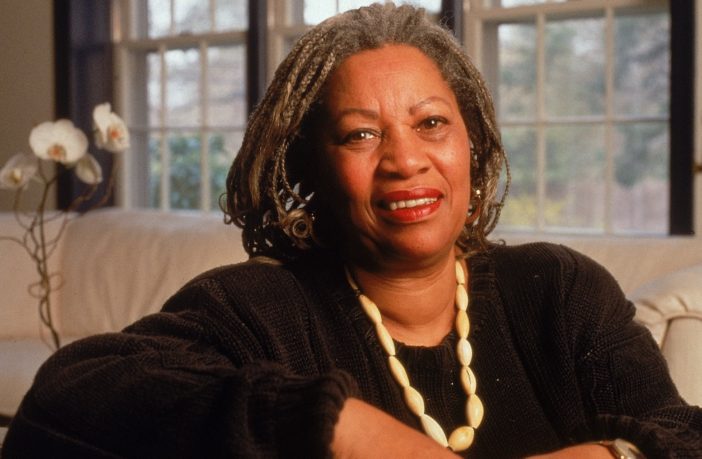Toni Morrison: Sites of Memory,—Princeton University’s exhibition of never-before-seen archives from the Toni Morrison Papers—is an intimate and introspective look at the famed writer’s creative process, from her early high school days through her most acclaimed works. The six-part presentation doesn’t follow a precise chronological order and instead focuses on how her work evolved through copious research, meticulous outlining and many drafts and rewrites that would become the novels that have moved millions.
“This is a really important part of the creative life, but also one that we are not always afforded to Black writers. There’s a way in which they always have to arrive fully formed, where there’s no room, time or luxury to be in process and be messy or take routes that might not actually seem to pan out,” says Princeton Associate Professor of African American Studies and English Autumn Womack, who curated the exhibit. “We’re asking visitors to suspend the idea of Toni Morrison as an icon and begin to think about what kind of stories, histories and relationships emerge when we think of her just as a writer and artist.”
Toni Morrison: Sites of Memory is paired with Cycle of Creativity, an installation by visual artist Alison Saar. In addition, performance artists Daniel Alexander Jones and Mame Diarra were given access to Morrison’s unfinished works to inspire an in-process staging that premiered at the university’s McCarter Theatre in March.
Sites of Memory: Toni Morrison. Image: Brandon Johnson.
Here are six fascinating facts about Morrison that the exhibition brings to light.
Morrison’s editorial process started as early as high school.
Morrison was on the yearbook committee at an integrated high school in the ethnically-diverse, working-class town of Lorain, Ohio. It’s where her first book, The Bluest Eye, which was published in 1970, takes place. “That editorial practice and attention she cultivated really emerged and came into play when she set about publishing her novel,” Womack shares, pointing to Morrison’s exchange with publishing houses. “We wanted to highlight her editorial correspondence with two different editors that she was pitching, negotiating her own status as both editor and writer.”
She wrote whenever and on whatever she could.
When ideas came to Morrison, she would write them down, no matter where she was.“When she was an editor at Random House, she found the time to write in day planners,” says Womack. Several pages of her work that were in a fire at her New York home in 1993 are also on display. “A ton of her research files were destroyed. She was teaching here at the time, but they were able to conserve and preserve a bunch of the material,” Womack shares. “It’s where we see her doing multiple kinds of writing and work at the very same time.”
She used geometry to plan out her novels.
One section of the exhibit explores how geography and drawing play a role in Morrison’s work. “Spatial coding was a really crucial part of her creative process and practice and thinking,” Womack explains. “She did hand-drawn maps and outlined almost all of the geographic places and spaces in her novels. That entire geography had to be right before the characters could spring to life,” Womack shares. “For her, it was also about imagining spaces and attributing feelings to them and how characters would feel when they’re in the spaces. She wasn’t just geographically mapping physical spaces, but also a point of view and narrative voice.”
While she only published one short story, more exist.
Morrison’s only published short story may be Recitatif, but “there are at least five short stories in the exhibit. Most of them were written pretty early on,” Womack says. Morrison defined Recitatif as a narrative with the removal of all racial codes about two characters of different races for whom racial identity is crucial. “It becomes a challenge for the reader to try not to spend their whole time trying to figure out who’s Black or white, and then to ask, why do I care so much,” Womack explains. “For me, that exercise kind of gets complicated when we think that she first wrote Recitatif as a play and then a film, and actually cast Cicely Tyson in one of the roles.”
Around 400 boxes of Morrison’s papers were reviewed for the exhibit.
The acclaimed writer amassed a large collection of belongings during her 17 years teaching at Princeton, which led to the six-part exhibition that delves into her thoughts, processes and motivations. “Each part kind of unravels a different part of her practice in her creative life,” Womack declares.
Her name is a nom de plume.
Before moving into novels, Morrison dabbled in short stories, which are on display at the Princeton exhibit, and many carry different iterations of what would ultimately become her pen name. “She was born Chloe Wofford,” Womack declares. “In one of her short stories from the 1950s, she tries signing her name as Chloe Morrison, Toni Wolford and Chloe Wofford Morrison. There were all these different ways that she was experimenting with whom she would become.”
Toni Morrison: Sites of Memory, at Princeton University’s Ellen and Leonard Milberg Gallery, Firestone Library, runs through June 4, 2023.


